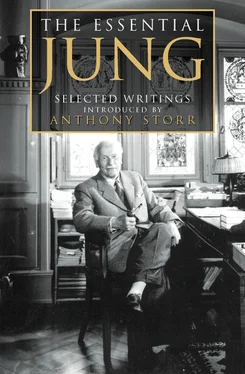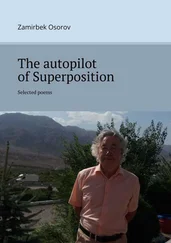Examples of archetypes as images of ideas are given in extracts which follow.
It was also Jung’s study of schizophrenia which led him to formulate a different, and more general, view of psychic energy from that of Freud. Freud believed that schizophrenia, in common with other mental disturbances, was due to repression of sexuality and withdrawal of erotic interest from objects in the external world into the inner world of the subject. Jung considered that contact with the external world was maintained in other ways beside the sexual; and that the loss of contact with reality characteristic of schizophrenia could not be attributed to sexual withdrawal alone. Because of this, he came to use the term “libido” for psychic energy in general, without limiting it to sexuality.
While Jung was still at the Burghölzli, his private practice was also growing, so that he became as familiar with the various types of neurosis as he was with schizophrenia and the other psychoses. His divergence from Freud became wider. Freud believed that neurosis invariably originated in early childhood, and that the incestuous fantasies and desires connected with the Oedipus complex were central factors. (Freud made an exception in the case of so-called “traumatic” neurosis; but this did not form a main part of his theory.) Jung thought that the cause of neurosis usually lay in the present; and that the infantile fantasies which Freud unearthed were secondary phenomena. When the natural course of a man’s development through life was held up, either by misfortune or by his failure to face life’s obligations, his libido became turned in upon himself and reactivated the attitudes and feelings of childhood which would normally have been left behind him. Jung believed that there was a natural and proper path of development for each individual; and that neurosis might actually be a valuable signal which indicated when, through intellectual arrogance, a false set of values or an evasion of responsibilities, a person was straying too far from his own true path. Neurotic symptoms, therefore, might be compensatory; part of a self-regulating mechanism whose aim was the achievement of a better balance within the psyche. Jung sometimes said of an individual: “Thank God, he became neurotic!” Just as pain might make a man realize that there was something wrong with his body, so neurotic symptoms could draw attention to psychological problems of which the individual was unaware.
The idea of self-regulation runs right through the whole of Jung’s scheme of how the mind works, and largely accounts for his view of dreams. Freud considered that the majority of dreams had as their core an unacceptable wish which was striving, in the dream, to find indirect expression. He believed that the “manifest content” of a dream was merely a cloak concealing the “latent content,” which was generally some repressed sexual desire of an infantile kind. Jung, on the other hand, regarded dreams as communications from the unconscious. Dreams might be couched in symbolic language which was hard to understand; but they were not necessarily concerned with wishes, nor ways of concealing the unacceptable. Most commonly, dreams were compensatory to the conscious point of view; expressions of aspects of the individual which were neglected or unrealized; or, like neurotic symptoms, warnings of divergence from the individual’s proper path. Dreams from the collective level might sometimes be visions of vast significance, quite outside the range of conscious contrivance.
The idea of compensation and self-regulation also became linked with Jung’s classification of “psychological types.” It was Jung who introduced the terms “extravert” and “introvert” into psychology. Jung’s observation of the very different ways in which Freud, Adler and he himself approached the same psychological material led him to postulate that individuals adopted differing habitual attitudes toward life which determined their interpretation of experience. The extravert’s bias was toward the external world; the introvert’s, toward the inner world of the psyche. Jung later proposed that the psyche operated by means of four functions: thinking, feeling, sensation and intuition. Any one of these functions could also be predominant in an individual’s way of dealing with experience. For example, a man could be an introverted thinker or an extraverted intuitive or an introverted feeling type. The eight possible types are vividly described in volume 6 of the Collected Works, Psychological Types.
Compensation and self-regulation are integral parts of this type theory. Jung considered that habitual attitudes were nearly always carried too far, so that the thinker neglected his feelings, while the intuitive paid too little attention to the facts given by sensation. Introverts were caught up in their inner worlds; while extraverts lost themselves in the press of events. In Western man, because of the achievements of his culture, there was an especial tendency toward intellectual hubris; an overvaluation of thinking which could alienate a man from his emotional roots. Neurotic symptoms, dreams and other manifestations of the unconscious were often expressions of the “other side” trying to assert itself. There was, therefore, within every individual, a striving toward unity in which divisions would be replaced by consistency, opposites equally balanced, consciousness in reciprocal relation with the unconscious. Jung affirmed that personality was manifested by “definiteness, wholeness and ripeness”. (CW 17, par. 288) He considered personality to be an achievement, not something given. Moreover, it was essentially an achievement of the second half of life. In the first half of life, a person is, and should be, concerned with emancipating himself from parents and with establishing himself in the world as spouse, parent and effective contributor. In the modern world, especially, a certain one-sidedness might be needed to fulfil these conventional demands; but, once a person had done so, then he could and should look inwards. Jung called the journey toward wholeness the “process of individuation,” and it is toward the study of this process that the thrust of his later work is directed.
Jung’s later writings are much concerned with alchemy. Although the ostensible purpose of alchemy was to find a way of changing base metals into gold, the early alchemists “sought not only to make gold, but to perfect everything in its own nature” (F. Sherwood Taylor, The Alchemists, London: Heinemann, 1951, p. 3). Moreover they linked change in matter with change in man, so that the alchemical “work” aimed at perfecting matter was, at the same time, a psychological process aimed at perfecting man. Some of the alchemists undoubtedly thought of their work as a meditative development of the inner personality; and this is why their writings appealed to Jung, who found parallels between the series of changes described by the alchemists and the process of individuation which he observed taking place within his patients. Individuation is essentially a spiritual journey. “Only the man who can consciously assent to the power of the inner voice becomes a personality.” (CW 17, par. 308) By paying attention to the voice within, the individual achieves a new synthesis between conscious and unconscious, a sense of calm acceptance and detachment, and a realization of the meaning of life.
If the unconscious can be recognized as a co-determining factor along with consciousness, and if we can live in such a way that conscious and unconscious demands are taken into account as far as possible, then the centre of gravity of the total personality shifts its position. It is then no longer in the ego, which is merely the centre of consciousness, but in the hypothetical point between conscious and unconscious. This new centre might be called the self. [CW 13, par. 67]
Читать дальше












